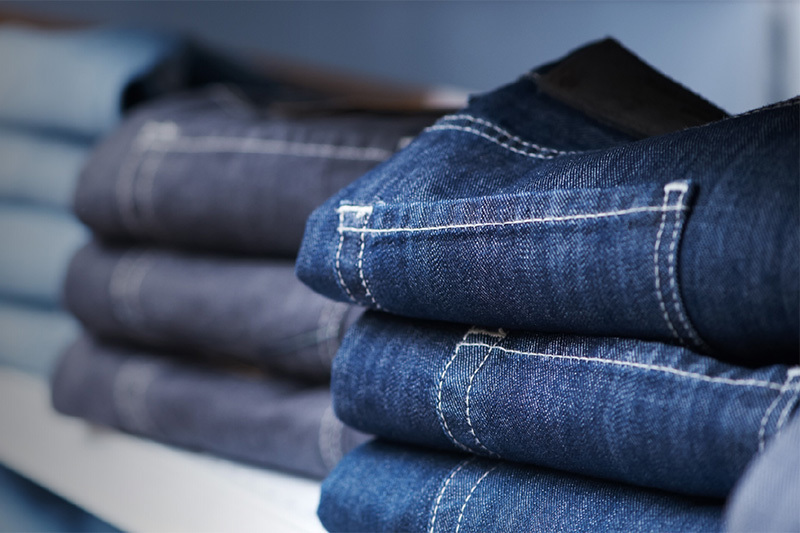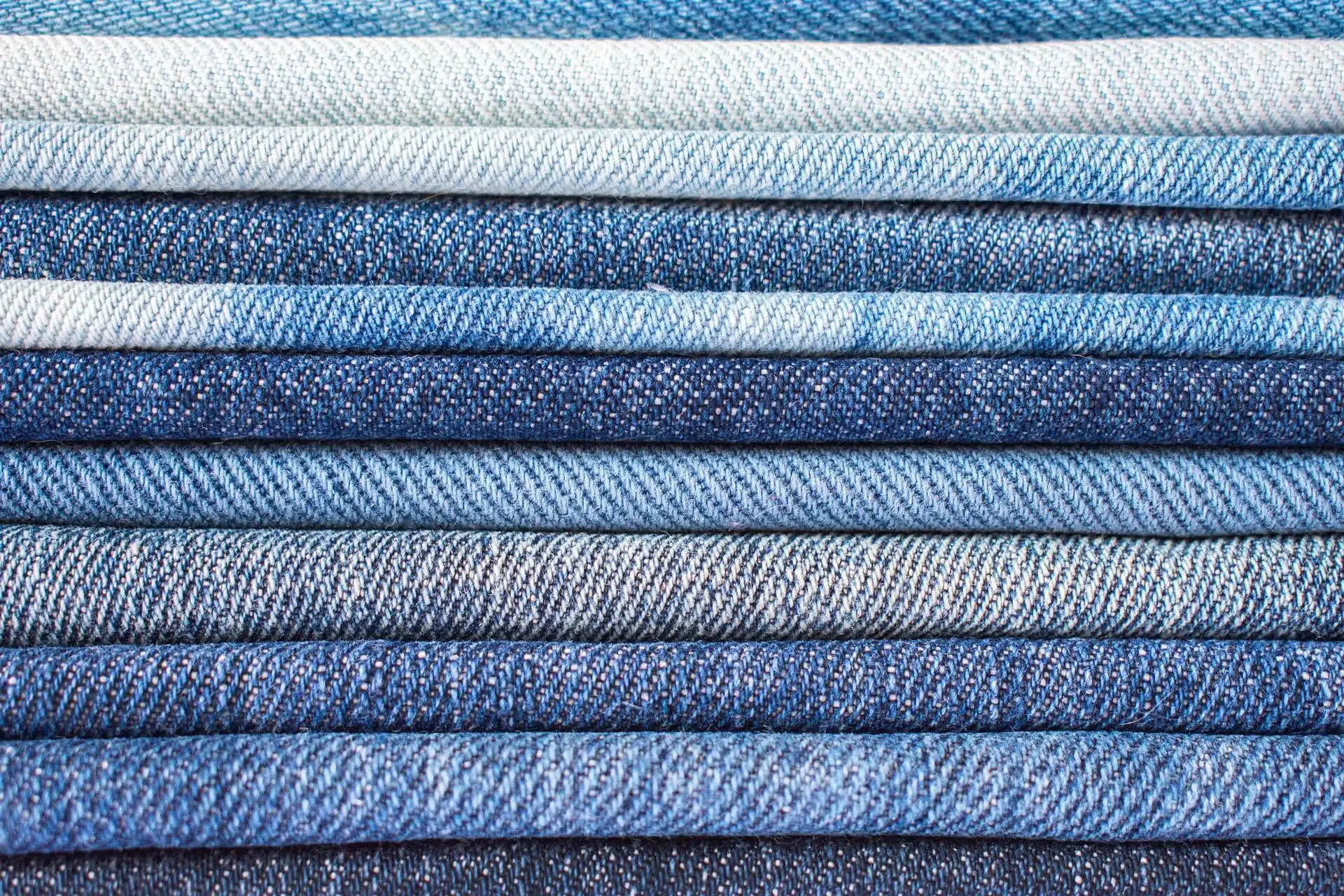Introduction to various denim washing processes
Release time:
13 Mar,2025
The washing process for jeans, an indispensable part of the manufacturing process, is usually completed in a professional washing plant. This process not only significantly improves the feel and appearance of the jeans, but also gives them a unique style and texture.

The washing process for jeans, an indispensable part of the manufacturing process, is typically completed in a professional washing plant. This process not only significantly improves the feel and appearance of the jeans but also gives them a unique style and texture.
The washing process includes multiple stages, one of which is desizing. Currently, most denim fabrics are softened using a fiber enzyme wash. In the production of denim, regardless of its thickness, a corn starch sizing is applied to enhance the stiffness of the yarn. Desizing is the reverse of this process, using fiber enzymes to break down and remove the sizing from the denim. Although desizing causes slight fading of the denim, it significantly improves its softness and drape. Lightweight denim treated with this process can be cleverly made into tablecloths or napkins with a soft touch and excellent drape.
Stone Washing:
Stone washing is a process that uses physical methods to fade denim while enhancing its color contrast. In this process, a 20-yard-long, 62-inch-wide roll of denim is placed in a 250-pound washing tank containing pumice stones. The fabric and stones mix and tumble in the tank, rubbing against each other, and the length of time they tumble determines the final color depth of the denim. After prolonged washing, the color of the denim gradually lightens, and the color contrast becomes more pronounced. After washing, the denim undergoes subsequent finishing steps such as rinsing, softening, and drying. The softness and rich color gradation of the denim after this series of processes make it an ideal choice for home textiles and the apparel industry.
Enzyme Wash:
Enzymes, as a type of cellulase, are designed to degrade cellulose in cotton fibers. Under specific pH and temperature conditions, it can effectively degrade the fiber structure, washing away the fibers and the attached indigo dye. This process allows the fabric to fade in a relatively gentle way, producing a unique "peach skin" effect and achieving lasting softness, making it ideal for home textiles and apparel.
Sand Washing Process:
In the sand washing process, alkaline or oxidizing agents are usually used to give the garment a certain fading effect and vintage feel. If combined with stone washing technology, a fine, soft, frosty white fluff will form on the surface of the washed fabric. In addition, adding a softener can make the fabric soft and comfortable to the touch, thereby improving wearing comfort.
Finishing:
Since denim dyes mainly adhere to the surface of the yarn, preventing other fabrics from being dyed by denim is an important issue in the production process. The application of chemicals such as resins and color fixatives can effectively solve the problem of friction fading, especially when dealing with darker denim. At the same time, waterproof treatment is also an indispensable step, which can enhance the durability of denim and reduce fading during home cleaning and outdoor wear.
Rinsing:
In order to give the garment a white or bright appearance and a soft feel, rinsing is an indispensable step. After normal washing, the garment needs to be soaked in warm water at about 60℃, and an appropriate amount of bleaching agent is added according to the required bleaching degree. After a bleaching process of 7-10 minutes, the color of the garment will reach the preset standard. Then, stone grinding is carried out, and this process is called stone bleaching.
Bleaching technology is divided into oxygen bleaching and chlorine bleaching. Oxygen bleaching uses hydrogen peroxide for bleaching, and its characteristic is that the bleached fabric surface may be slightly red. Chlorine bleaching uses sodium hypochlorite for bleaching, and its fading effect is more obvious, especially suitable for the bleaching needs of indigo denim.
Overdyeing Process:
Overdyeing denim is an indispensable step, and commonly used dyes include reduction dyes, sulfur dyes, reactive dyes, and direct dyes. However, reduction dyes and sulfur dyes are difficult to use in the dyeing process; they cannot be used in industrial washing machines and can only be used in specific dyeing vats, which limits their application to some extent. Currently, the more common practice is to use reactive dyes for dyeing. These dyes are usually used in a one-bath dyeing method at low temperatures, but it is necessary to ensure that they are thoroughly washed to neutral and dried promptly to prevent defects such as sealing. In addition, direct dyes are also commonly used dyes in clothing manufacturing. Their dyeing process is relatively simple, but their color fastness needs to be improved.
Dry Grinding (Stone Grinding) Process:
Pumice stones are placed in a tumbler, and diluted bleach (sodium hypochlorite solution) is added and stirred evenly to allow the pumice stones to fully absorb the solution. Then, the denim garments are put into the tumbler, and the rotation is started. The friction between the pumice stones, the garments, and the wall of the machine removes some of the dye from the surface of the garments. At the same time, the ash produced by the pumice stones stains the garments, and the bleach component in this ash, through oxidation, destroys the indigo or sulfur dye on the garments, thus achieving a stripping and bleaching effect.
Snowflake Tumbling Process:
Through tumbler operation, this process can produce a whiter whiteness, presenting a significant contrast in lightness, although the uniformity is not as good as dry grinding. In this process, white spots like large snowflakes appear on the surface of the garment, hence the name snowflake tumbling. The core principle is to soak dry pumice stones in a potassium permanganate solution and then directly grind them with the garment in a special rotating cylinder. During the friction between the grinding stone and the garment, the potassium permanganate oxidizes the friction points, thus forming irregular faded areas on the fabric. These areas intertwine, resembling snowflake patterns.
Machine Rubbing Process:
Electric brushes or grinding wheels are used to directly grind the surface of the fabric to achieve a local whitening effect on the garment. This process is particularly suitable for large areas such as the front legs, knees, and back buttocks.
This machine rubbing process first uses a blowing machine, such as a vertical grinding machine, and an inflatable model "gel wave" to moderately inflate the pants and secure their shape. Then, electric equipment is used to finely grind the pants to create the desired whitening effect. Finally, the seams, pocket edges, and hem edges are manually trimmed to ensure the desired special effect.
Next, we introduce hand-rubbing techniques, which encompass several methods such as hand-brushing, sandpaper rubbing, and knife rubbing. Hand-rubbing techniques essentially involve using tools like sandpaper, blades, or small grinders to physically damage the fibers on the surface of the garment, thereby achieving a fading effect. It's worth noting that the common whisker effect is a specific application of hand-rubbing techniques.
Whisker Effect:
This effect is named for its resemblance to cat whiskers. Whiskers can be achieved through post-sewing washing or horse-hair brushing techniques, or even directly created using a grinding wheel. The shape and clarity are important indicators of the whisker effect, although there is no unified standard. However, combining resin three-dimensional creasing and horse-hair brushing techniques can create three-dimensional whiskers, classified as flat whiskers and round whiskers.
Resin Creasing Technique:
According to processing needs, create lasting specific creases, and combine with horse-hair brushing, sandblasting, or hand-rubbing techniques to highlight a unique style. In this process, it is necessary to ensure that the three-dimensional shape retention is durable, has excellent strength retention, and is free from blemishes such as horse-hair yellow spots. At the same time, the formaldehyde residue must meet national standards, and the base color should remain pure and not overflow.
Sandblasting Technique:
This technique uses compressed air as its driving force, and a special nozzle is used to spray high-speed abrasive sand onto the surface of the jeans. With the grinding effect of the abrasive sand, the wear and fading effect on the surface of the garment is created. It is worth noting that the abrasive sand can be recycled; it only needs to be recovered and added back to the sand cylinder. However, the sandblasting work environment is relatively harsh, and operators must be equipped with a full set of dust protection measures.
Horse-hair Brushing (Potassium Permanganate and Phosphoric Acid Mixture Solution) Technique:
This technique is similar to sandblasting, but the mechanism of action is quite different. Horse-hair brushing sprays a mixture of potassium permanganate and phosphoric acid, namely horse-hair water, onto the garment according to the design requirements using a spray gun. Sometimes a template is also used to finely depict artistic patterns. This mixed solution has oxidizing properties and can destroy the indigo dye or high-quality sulfur dye on the surface of the denim, causing it to fade. Subsequently, the reaction product manganese dioxide of potassium permanganate is removed by washing with a reducing agent, making the surface of the garment appear frost-white, which is what is called "horse-hair brushing".
The degree of the fading and frost-white effect of the horse-hair brushing technique can be precisely controlled by adjusting the concentration and spraying amount of the horse-hair water. Compared with hand-rubbing and sandblasting, the horse-hair brushing technique has a more even and higher intensity of fading, and causes almost no physical damage to the garment itself.
Craquelure (Ice Crack) Technique:
This technique is essentially a variant of the horse-hair brushing technique. The key lies in the use of "craquelure paste." During the production process, this paste is applied manually to the surface of the denim garment in an appropriate thickness, and then dried (usually in an oven). After drying, the craquelure paste on the surface of the garment will crack naturally, forming various cracks. Then, the garment is treated with horse-hair brushing. The horse-hair brushing solution will seep into these cracks and react with the dye of the garment. Finally, after washing away the remaining paste and performing reduction and neutralization treatment, the surface of the garment will show white lines consistent with the cracks, which is the so-called "craquelure" or "ice crack" effect.
Laser Engraving Technique:
Using laser technology, the blue color on the surface of the yarn is removed, thereby engraving unique patterns on the fabric. In addition, this technique can also cut out various beautiful patterns with hollow effects on the surface of the fabric, further enhancing the product's sophistication and innovation.
Other Techniques:
In addition to laser engraving, there are a variety of techniques such as grinding, holes, hand-needle picking and washing, hand-painting, tie-dyeing, and cutting, which can bring unique visual effects to the fabric.
- All
- Product Management
- News
- Introduction
- Enterprise outlets
- FAQ
- Enterprise Video
- Enterprise Atlas
More information







